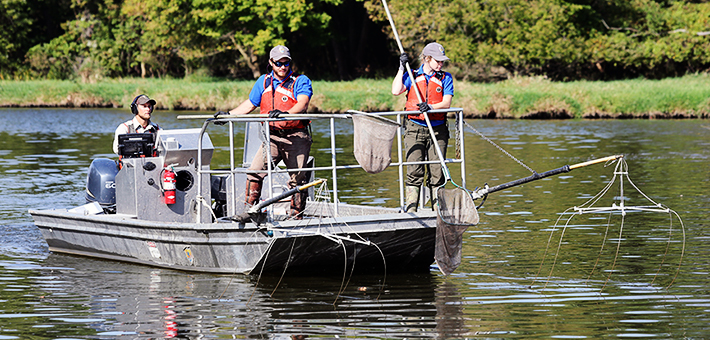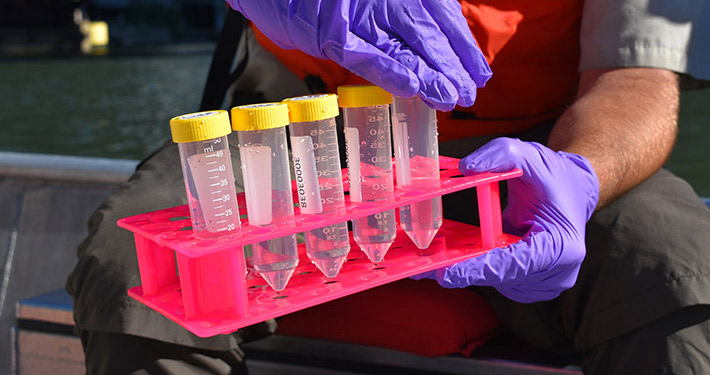Early Detection, Monitoring and Assessment

A team of biologists electrofishing. Photo by USFWS.
Monitoring, early detection and assessment are key strategies used by Invasive Carp Regional Coordinating Committee (ICRCC) members to address the threat of invasive carp to the Great Lakes.
Monitoring
Comprehensive and science-based monitoring provides resource managers with the tools to determine the distribution, abundance and demographics of invasive carp populations, and to detect new occurrences early. Monitoring is a critical component of early detection efforts.
- In the United States, the U.S. Fish and Wildlife Service works with partner agencies to conduct early detection monitoring of aquatic invasive species, including invasive carp, in the U.S. waters of the Great Lakes through the Great Lakes Aquatic Invasive Species Early Detection program. Sampling strategies are coordinated on an annual basis with federal, state, tribal, and provincial partners to identify priority sampling locations, refine protocols and share information.
- Within the Canadian waters of the Great Lakes and their tributaries, Fisheries and Oceans Canada, the Ontario Ministry of Northern Development, Mines, Natural Resources and Forestry, and the Québec Ministère des Forêts, de la Faune et des Parcs are conducting monitoring for invasive carp. Environmental DNA, or eDNA, monitoring is also used in these locations.
- The ICRCC supports continued monitoring and assessment of black carp movement. There is increasing concern for the potential spread of black carp toward the Great Lakes, with a focus on the Illinois River. The Black Carp Work Group was formed to evaluate the status of this species, identify management needs and objectives, and develop a strategy for implementing high-priority monitoring and control actions.
Early Detection
Early detection includes observing, documenting, and communicating the presence of an invasive carp, particularly in locations where the species are not known to be established and in critically important areas like the Chicago-Area Waterway System.
The science of environmental DNA, known as eDNA, is used as an early detection monitoring tool to protect the Great Lakes. Strategic eDNA surveillance for silver carp and bighead carp is conducted in the Great Lakes, Upper Mississippi and Ohio River basins; in the Canadian waters of the Great Lakes and its tributaries, strategic and targeted eDNA surveillance is conducted for all four species of invasive carp. Examples of early detection efforts in the U.S. and Canada include:
- Since 2012, Fisheries and Oceans Canada and the Ontario Ministry of Northern Development, Mines, Natural Resources and Forestry, have implemented an early detection surveillance program for Canadian waters of the Great Lakes.
- The Illinois Department of Natural Resources leads annual seasonal intensive monitoring throughout the Chicago Area Waterway System to detect silver and bighead carp. The event is conducted with support from the ICRCC and several partner organizations.
Risk Assessment
Risk assessments are a valuable resource that help agencies make informed decisions about where and how to invest in effective prevention, early detection, and management actions.
Bi-national ecological risk assessments have been conducted for bighead carp and silver carp (2012), and grass carp (2017) which summarize the potential ecological consequences should these species become established in the Great Lakes basin. A risk assessment for black carp is being developed.
Monitoring and Response Work Group
The Monitoring and Response Work Group is an interagency group of fisheries biologists and scientists who coordinate monitoring, response, control, and management actions in the Illinois River and Chicago Area Waterway.
Resources
Environmental DNA
Read about eDNA sampling as an early detection method »

Environmental DNA sampling tubes. Photo by USFWS.
Risk Assessments
Binational Ecological Risk Assessment of Bigheaded Carps for the Great Lakes Basin
Ecological Risk Assessment of Grass Carp for the Great Lakes Basin (PDF)
